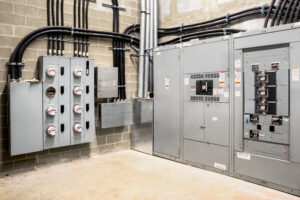Voltage is a fundamental unit of electricity, and it is essential to understand how voltage affects various electrical systems, especially for facility managers in charge of large commercial buildings. Voltage measures the electrical potential difference between two points in an electrical circuit. In this blog, we will explore what DC and AC voltage are, how they are used, and how energy management systems can prevent voltage imbalances with main load metering.
buildings. Voltage measures the electrical potential difference between two points in an electrical circuit. In this blog, we will explore what DC and AC voltage are, how they are used, and how energy management systems can prevent voltage imbalances with main load metering.
What are VDC and VAC Voltage?
VDC (Volts Direct Current) is the voltage of a direct current (DC) circuit. Direct current is a type of electrical current that flows in one direction only. Unlike alternating current (AC), which changes direction periodically, DC current flows in a constant direction. VDC is measured in volts and is used to power various electrical devices, such as batteries, electronic circuits, and motors. DC voltage can be generated by batteries, power supplies, and solar cells.
VAC (Volts Alternating Current) is a measure of the strength of the alternating electric field that drives the flow of electrons in AC electrical systems. Unlike DC (Direct Current) voltage, which remains constant, VAC fluctuates sinusoidally, reversing direction periodically at a fixed frequency, typically 50 or 60 Hertz. The peak voltage of an AC waveform is measured in volts and is the maximum voltage that can be achieved during each cycle. In AC electrical systems, VAC is controlled using transformers, which can step up or step down the voltage to suit the needs of different applications.
VDC Versus VAC
The main difference between DC (Direct Current) and AC (Alternating Current) power lies in the direction of the flow of electrons. In DC applications current flows in one direction only, from the positive terminal to the negative terminal, while AC power changes direction periodically, typically at a frequency of 50 or 60 hertz. Another significant difference is that DC power has a constant voltage and current, while AC power varies both in voltage and current over time. DC power is commonly used in electronic devices, batteries, and automobiles, while AC power is used in HVAC systems, refrigeration systems, and commercial building lighting. Understanding the differences between DC and AC power is essential for facility and building managers.
How is DC Voltage Used?
VDC (Volts Direct Current) is a critical parameter in many applications involving solar power, battery power, and EV fast chargers. In solar power systems, VDC is used to match the output voltage of solar panels to the input voltage of inverters that convert DC power into AC power. In battery power applications, VDC determines the amount of power that can be drawn from batteries and how fast they can be charged. In EV fast chargers, VDC is used to convert AC power from the grid to DC power for charging electric vehicles quickly. Higher voltage DC power can reduce charging times significantly and are critical for supporting the rapid growth of EV adoption. In all these applications, VDC plays a vital role in ensuring efficient and reliable power delivery.
How Voltage Imbalances Can Negatively Affect Commercial Buildings
Systems such as commercial HVAC use a significant amount of electricity to regulate the temperature and air quality in large commercial buildings. These systems are critical for maintaining comfortable working conditions for employees and customers and keeping equipment in good working order. However, if the voltage supplied to the HVAC system is not stable or balanced, it can negatively affect the system’s performance and lifespan.
When the VAC voltage supplied to the HVAC system is too high or too low, it can cause the system to operate inefficiently or even fail altogether. For example, if the voltage is too low, the system may not be able to start, or it may run slower than normal. Conversely, if the voltage is too high, it can cause windings in motors to overheat or lead to premature failure of mechanical equipment.
If the main load voltage is not well-balanced, that means the utility may be supplying the building with dirty power.
What Causes Voltage Imbalances?
Dirty power, also known as electrical noise or electromagnetic interference (EMI), refers to the presence of unwanted electrical signals in the power supply. These signals can cause voltage and current waveforms to become distorted, resulting in voltage imbalances. This occurs because dirty power can generate additional frequencies that deviate from the fundamental frequency of the power supply. These frequencies can cause the voltage to fluctuate, resulting in an imbalance across the three phases of voltage supplied to the building’s assets. Additionally, dirty power can cause overheating, malfunctioning, or damage to electronic equipment, which can lead to safety hazards and increased costs. It is important to maintain clean power to ensure efficient and safe operation of electrical systems.
A utility company may inadvertently provide dirty power due to a variety of factors, including equipment malfunctions, faulty wiring, and inadequate maintenance. Additionally, the presence of heavy electrical loads, such as those in industrial areas, can cause voltage fluctuations and distortions in the power supply.
How Energy Management Systems Can Prevent Problems with Voltage Imbalances.
Energy management systems (EMS) can help prevent voltage imbalances by monitoring the electrical supply to the HVAC system and other equipment. EMS systems use main load metering to monitor the amount of energy consumed by the equipment and identify any voltage imbalances that may be present.
Main load metering involves measuring the total energy consumption of the HVAC system and other equipment in real-time. This information is then analyzed to identify any voltage imbalances that may be present, and corrective measures can be taken to balance the voltage supply.
EMS systems can also help prevent voltage imbalances by identifying areas where energy consumption can be reduced, such as by optimizing fast EV chargers and reducing energy waste. By reducing energy consumption, EMS systems can help balance the voltage supply and prolong the lifespan of the equipment.
VDC and VAC are essential units of electricity that power various electrical devices, including commercial HVAC systems. However, if the voltage supply is not stable or balanced, it can negatively affect the performance and lifespan of the equipment. Dirty power and voltage imbalances can cause a range of problems, including increased energy consumption and higher operating costs. Energy management systems can help prevent voltage imbalances by monitoring VDC and VAC of commercial buildings.
See how GridPoint’s EMS can help monitor your VDV voltage and prevent and imbalance.

Jack French, | Senior Manager, Energy Analytics
Jack French holds a leadership role at Gridpoint developing the Site Acceptance and Proactive Monitoring teams. His experience spans multiple disciplines including data validation, advanced analytics, measurement & verification, customer engagement, and control optimization.